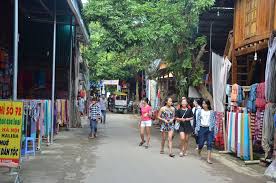
(HBO) - In nine months of 2019, Hoa Binh province welcomed about 2.5 million tourists. In which, international visitors were 290,000; domestic visitors 2.21 million. Total revenue from tourism is estimated at VND 1,650 billion, reaching 82.5% of the year plan. Some districts in the province have a large number of tourists such as: Mai Chau, Kim Boi, Da Bac and Hoa Binh cities...
Department of Culture, Sports and Tourism has promoted the promotion and introduction on mass media about the Provincial Culture and Tourism Week in early November 2019. This is an opportunity to attract a large number of tourists to visit and learn about the unique cultural values of Hoa Binh province.
Located just a 20-minute drive from Hoa Binh City, Ora Hill Farmstay & Glamping Hoa Binh is a captivating new destination nestled in Mo hamlet, Bình Thanh commune, Cao Phong district. Combining farming with leisure, this tranquil retreat is perfect for those seeking balance, joy, and an immersive experience in the expansive beauty of nature.
Muong Bi - Tan Lac is renowned as one of the four famous Muong regions in Hoa Binh province. Blessed by nature with a favourable climate and stunning landscapes, Tan Lac holds great advantages for tourism development. The local tourism industry has made remarkable strides in recent times thanks to the attention and support from the local authorities and sectors.
With its strategic location, well-developed transport network, and diverse soil and climatic conditions, Hoa Binh is emerging as a must-visit destination in Vietnam's northwestern tourism corridor. The province boasts numerous attractions, including the Kim Boi hot springs (Kim Boi district), the Dau Rong cave complex (Cao Phong), the Mai Chau valley (Mai Chau), and the iconic Hoa Binh hydropower plant.
The northern mountainous province of Hoa Binh has been listed among the 71 most beautiful places to visit worldwide by the prestigious US travel magazine Condé Nast Traveller.
Hoa Binh province’s rich natural and cultural resources position it as a prime location for developing community-based tourism (CBT). In recent years, support from central and provincial policies, as well as assistance from non-governmental organisations, have encouraged local ethnic minority and mountainous communities to actively engage in the sector.


